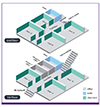1. Wong Samson SY, Yuen KY.
Streptococcus pyogenes and re-emergence of scarlet fever as a public health problem. Emerg Microbes Infect. 2012; 1:e2.
2. Heymann DL. Control of communicable disease manual. 19th ed. Washington, DC: American Public Health Association;2008. p. 577–585.
3. Lamden KH. An outbreak of scarlet fever in a primary school. Arch Dis Child. 2011; 96:394–397.

5. Korea Center for Disease Control and Prevention (KCDC). Case definition for national notifiable infectious disease. Osong: KCDC;2016.
6. Weiss K, Laverdière M, Lovgren M, Delorme J, Poirier L, Béliveau C, Group A.
Streptococcus carriage among close contacts of patients with invasive infection. Am J Epidemiol. 1999; 149:863–868.

7. Wagenvoort JH.
1, Penders RJ, Davies BI, Lütticken R. Similar environmental survival patterns of
Streptococcus pyogenes strains of different epidemiologic backgrounds and clinical severity. Eur J Clin Microbiol Infect Dis. 2005; 24:65–67.

8. Kaplan EL. Group A streptococcal carriers and contacts: (when) is retreatment necessary?. In : Shulman S, editor. Management of pharyngitis in an era of declining rheumatic fever. Columbus, OH: Ross Conference on Pediatric Research;1984. p. 92.
9. Shaikh N, Leonard E, Martin JM. Prevalence of Streptococcal pharyngitis and streptococcal carriage in children: a meta-analysis. Pediatrics. 2010; 126:e557–e564.

10. Park DW, Kim SH, Park JW, Kim MJ, Cho SJ, Park HJ, Jung SH, Seo MH, Lee YS, Kim BH, Min H, Lee SY, Ha DR, Kim ES, Hong Y, Chung JK. Incidence and characteristics of scarlet fever, South Korea, 2008-2015. Emerg Infect Dis. 2017; 23:658–661.

11. Turner CE, Pyzio M, Song B, Lamagni T, Meltzer M, Chow JY, Efstratiou A, Curtis S, Sriskandan S. Scarlet fever upsurge in England and molecular-genetic analysis in North West London, 2014. Emerg Infect Dis. 2016; 22:1075–1078.

12. Yan JJ, Liu CC, Ko WC, Hsu SY, Wu HM, Lin YS, Lin MT, Chuang WJ, Wu JJ. Molecular analysis of group A streptococcal isolates associated with scarlet fever in southern Taiwan between 1993 and 2002. J Clin Microbiol. 2003; 41:4858–4861.

13. Tse H, Bao JY, Davies MR, Maamary P, Tsoi HW, Tong AH, Ho TC, Lin CH, Gillen CM, Barnett TC, Chen JH, Lee M, Yam WC, Wong CK, Ong CL, Chan YW, Wu CW, Ng T, Lim WW, Tsang TH, Tse CW, Dougan G, Walker MJ, Lok S, Yuen KY. Molecular characterization of the 2011 Hong Kong scarlet fever outbreak. J Infect Dis. 2012; 206:341–351.

14. Guy R, Williams C, Irvine N, Reynolds A, Coelho J, Saliba V, Thomas D, Doherty L, Chalker V, von Wissmann B, Chand M, Efstratiou A, Ramsay M, Lamagni T. Increase in scarlet fever notifications in the United Kingdom, 2013/2014. Euro Surveill. 2014; 19:20749.

15. Stewart EH, Davis B, Clemans-Taylor BL, Littenberg B, Estrada CA, Centor RM. Rapid antigen Group A streptococcus test to diagnose pharyngitis: a systematic review and meta-analysis. PLoS One. 2014; 9:e111727.






 PDF
PDF ePub
ePub Citation
Citation Print
Print





 XML Download
XML Download